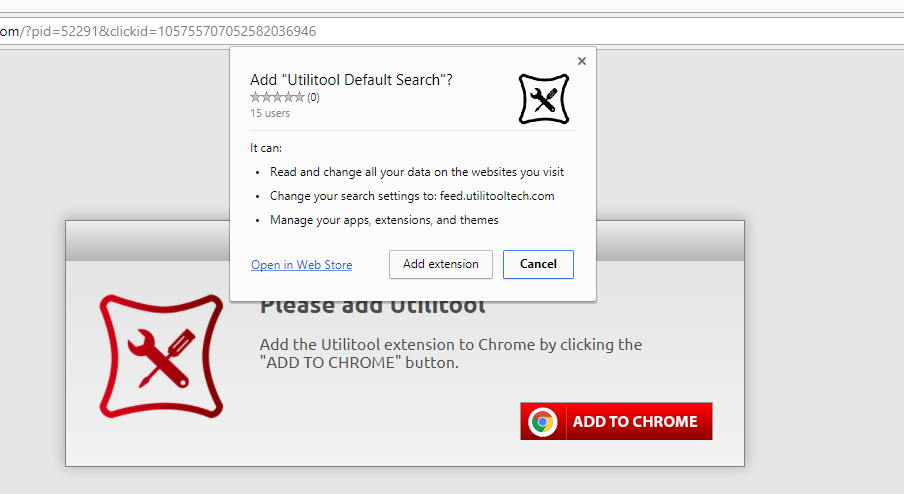Utilitool Default Search is identified as a potentially malicious browser extension that has excessive permissions allowing it to invade your privacy and modify your browser settings; resulting in redirected browser searches and a violation of privacy.

For example, the Utilitool Default Search extension for Google Chrome can read and change all your data on the websites you visit, change your search settings to feed. utilitooltech.com and other webites, and manage your apps, extensions, and themes.
These permissions allow it to modify your browser settings and gather information about your browsing habits. The extension generates revenue from the advertisements displayed on websites it redirects you to, sponsored search content, information it gathers and sells about you, and from affiliated downloads its able to make.
Furthermore, the Utilitool Default Search extension is advertised by malicious advertising networks on websites alongside malware, adware, spyware, and other malicious threats. This means that if you found Utilitool Default Search attached to your internet browser without your consent or knowledge it is likely that your computer is infected with other malicious programs.
The extension can also be automatically installed without user consent and knowledge by third-party malware, adware, download managers, and deceptive advertisements. These third-party objects will also infect your computer with additional malware and other threats.
How to remove Utilitool Default Searchal)
This Utilitool Default Search removal guide will help you remove Utilitool Default Search, viruses, malware, and other threats from your browser or PC. Follow each step below to remove this infection and protect yourself, friends, and your family from cyber criminals.
- Step 1: Remove Utilitool Default Search extension
- Step 2: Remove malware with Malwarebytes Anti-malware
- Step 3: Check your computer for malicious trace files with HitmanPro
- Step 4: Clean up and fix system issues with CCleaner
- Step 5: Manually repair browser settings (Optional)
1. Remove Utilitool Default Search extension
Chrome
1. Click the Customize and control Google Chrome icon and go to More tools > Extensions.
2. Click the trashcan icon next to the Chrome extension you want to remove.
Firefox
1. Open the Menu and click Add-ons.
2. Click Remove next to the Firefox add-on you want to remove.
Internet Explorer
1. Go to Tools (Alt+X) and click Manage add-ons.
2. Select the Internet Explorer add-on you want to remove with your mouse and click Remove.
Safari
1. Go to Safari > Preferences > Extensions.
2. Click the Uninstall button next to the Safari extension you want to remove.
2. Remove malware with Malwarebytes Anti-Malware
BUY NOW FREE TRIAL FREE DOWNLOAD
- Open your browser window and download Malwarebytes 3.0 Premium or Malwarebytes Anti-Malware Free.
- Open the executable file (mb3-setup.exe) to begin installing Malwarebytes.
- Select your language, click Next, then select “I accept the agreement,” click the Next button several times, and then click the Install button to install Malwarebytes. Click Finish once the install process is complete.
- Open Malwarebytes and click the Scan Now button on the Dashboard to begin scanning your computer.
- Click the Quarantine Selected button once the scan is finished.
- If Malwarebytes says “All selected items have been removed successfully. A log file has been saved to the logs folder. Your computer needs to be restarted to complete the removal process. Would you like to restart now?” click the Yes button to restart your computer.
3. Check your computer for malicious trace files with HitmanPro
- Open your browser window and download HitmanPro.
- Open the executable file (hitmanpro_x64.exe or hitmanpro_x32.exe) to begin installing HitmanPro.
- Click the Next button, check “I accept the terms of the license agreement,” and click the Next button again.
- On the Setup page select “Yes, create a copy of HitmanPro so I can regularly scan this computer (recommended)” and add your email address to the registration fields to begin the free trial.
- Click Next to begin scanning your computer.
- Once the Scan results are displayed click the Next button and click the Next button again on the Removal results page.
4. Clean up and fix system issues with CCleaner
BUY NOW FREE TRIAL FREE DOWNLOAD
- Open your browser window and download CCleaner Professional or CCleaner Free.
- Open the executable file (ccsetup.exe or other) to begin installing CCleaner.
- Click the Install button to begin stalling the program.
- Click Run CCleaner to open the program when installation is complete.
- Select the Cleaner tab and click the Analyze button.
- When the Analyze process is complete click the Run Cleaner button to clean all files.
- Next, select the Registry tab and click the Scan for Issues button to scan for issues in your registry.
- When the scan is complete click the Fix selected Issues button and Fix All Selected Issues button to fix the issues.
- Next, select the Tools tab and click Startup. Examine each area, search for suspicious entries, and delete any suspicious startup entries by selecting the entry and clicking the Delete button.
- Next, click Browser Plugins and search each internet browser for unwanted browser add-ons and extensions. Click the extension you want to delete and click the Delete button to remove it.


Leave a Comment